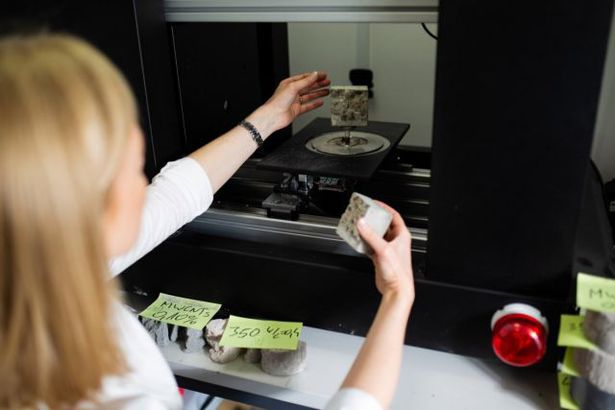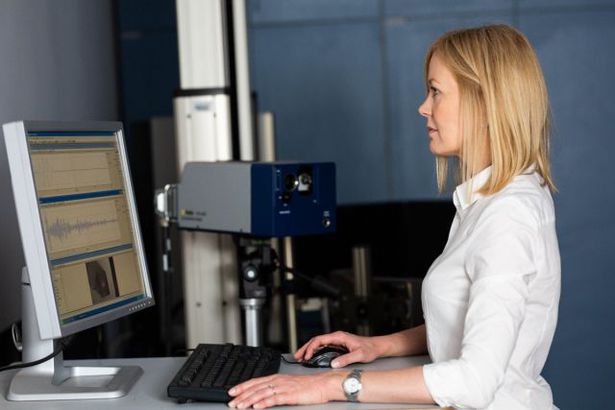Complex investigations of the development of micro- and macro-cracks in concrete members: experiments and discrete element method modelling
Keywords:
concrete, damage detection, micro-cracks, macro-cracks, discrete element, method, concrete meso-structure, micro-computed tomography, elastic wave propagation


Project description:
Concrete is one of the most common materials in civil engineering. The problem with concrete structures, however, is that they tend to fracture and crack with use; the mechanical properties of concrete are degraded due to environmental and operational loads. Microcracks appear even before a macrocrack shows up in an element. Detecting such microdamage at an early stage of degradation is not a trivial task and plays a vital role in civil engineering.
The research project aims to enhance the safety of concrete structures, using the phenomenon of elastic wave propagation. The characteristics of waves that propagate in mechanically degraded concrete are considerably altered, which makes it possible to detect incipient damage. From a broader perspective, the findings of the project can be expected to significantly contribute to the development of new monitoring techniques. A reliable way to assess the degree of concrete degradation in various structural elements will allow their maintenance costs to be rationalized and extend their service life.
The aim of the project is to explain the mechanism of propagation and scattering of elastic waves at the aggregate-level and their interaction with micro- and macro-cracking in concrete members subjected to monotonic quasi-static loading. Research investigations consist of two complementary parts: experimental and numerical. In the experimental part, a comprehensive program of monitoring of micro- and macro-cracks’ development in concrete specimens will be carried out by means of elastic waves. Two approaches using elastic waves will be used, i.e. the ultrasonic testing, where the elastic wave is generated by a PZT actuator, and the acoustic emission testing, where the elastic wave is generated by cracking of concrete. Additionally, the advanced micro-computed tomography system will be used for imaging the 3D concrete meso-structure and fracture evolution in concrete.
Since concrete has a special structure that is discontinuous and heterogeneous, wave propagation mechanisms in concrete elements will be described using an advanced mathematical model based on the discrete element method. In the numerical part the 4-phase concrete model will be used by including aggregates, cement matrix, macro-pores and interfacial transitional zones around aggregates. Calculations of elastic wave propagation in concrete elements will be conducted taking into account their real meso-structure obtained by means of micro-computed tomography.
The coupled experiments and calculations will yield new insight into the propagation of elastic waves in heterogeneous materials. The influence of concrete meso-structure on elastic wave scattering will be studied. Relationships between the micro/macro-cracks and characteristics of propagating acoustic and ultrasonic waves at the aggregate level will be elaborated. New algorithms capable of detecting micro-defect zones before the formation of visible damage will be developed.
Details
- Financial Program Name:
- OPUS
- Organization:
- Narodowe Centrum Nauki (NCN) (National Science Centre)
- Agreement:
- UMO-2019/35/B/ST8/01905 z dnia 2020-09-01
- Realisation period:
- 2020-09-01 - 2023-08-31
- Project manager:
- prof. dr hab. inż. Magdalena Rucka
- Team members:
-
- scholarship fellow Magdalena Knak
- researcher dr inż. Erwin Wojtczak
- researcher dr hab. inż. Łukasz Skarżyński
- researcher dr hab. inż. Michał Nitka
- researcher prof. dr hab. inż. Jacek Tejchman
- researcher dr inż. Monika Zielińska
- scholarship fellow Shahzad Ashraf
- Realised in:
- Department Of Mechanics Of Materials And Structures
- Project's value:
- 1 194 000.00 PLN
- Request type:
- National Research Programmes
- Domestic:
- Domestic project
- Verified by:
- No verification
Papers associated with that project
Filters
total: 11
Catalog Projects
Year 2025
-
A procedure for simulation-assisted identification of ultrasonic wave attenuation in heterogeneous materials and its application to the detection of fracture in concrete beams
PublicationIn this study, a novel procedure for identification of ultrasonic wave attenuation in heterogeneous materials based on signal energy was presented. The main objective was to develop a method for simple and robust determination of wave characteristics for further use in numerical modelling of ultrasonic wave propagation including attenuation of signals. Experimental investigations supported by numerical simulations were proposed...
Year 2024
-
Comparative study on fracture evolution in steel fibre and bar reinforced concrete beams using acoustic emission and digital image correlation techniques
PublicationIn recent decades, the demand for sustainable construction practices has increased, but raw materials such as reinforcing steel remain scarce. Therefore, steel fibres have emerged as a popular and sustainable choice in the construction industry, offering a cost-effective alternative to traditional steel bar reinforcement for both flatwork and elevated structures. The purpose of this study is therefore to compare the performance...
-
Crack monitoring in concrete beams under bending using ultrasonic waves and coda wave interferometry: the effect of excitation frequency on coda
PublicationConcrete is one of the most widely used construction materials in the world. In recent years, various non-destructive testing (NDT) and structural health monitoring (SHM) techniques have been investigated to improve the safety and control of the current condition of concrete structures. This study focuses on micro-crack monitoring in concrete beams. The experimental analysis was carried out on concrete elements subjected to three-point...
-
Discrete element method modelling of elastic wave propagation in a meso-scale model of concrete
PublicationThis paper deals with the accurate modelling of ultrasonic wave propagation in concrete at the mesoscopic level. This was achieved through the development of a discrete element method (DEM) model capable of simulating elastic wave signals comparable to those measured experimentally. The main objective of the work was to propose a novel methodology for constructing a meso-scale model of concrete dedicated to the analysis of elastic...
Year 2023
-
A study on microcrack monitoring in concrete: discrete element method simulations of acoustic emission for non-destructive diagnostics
PublicationThe research is focused on the monitoring of fracture evolution in concrete beams under three-point bending using the acoustic emission technique and the discrete element method. The main objective of the study was to numerically and experimentally investigate the mechanism behind the generation of elastic waves during acoustic emission events and their interaction with micro- and macro-cracking in concrete beams under monotonic...
-
Coda wave interferometry in monitoring the fracture process of concrete beams under bending test
PublicationEarly detection of damage is necessary for the safe and reliable use of civil engineering structures made of concrete. Recently, the identification of micro-cracks in concrete has become an area of growing interest, especially using wave-based techniques. In this paper, a non-destructive testing approach for the characterization of the fracture process was presented. Experimental tests were made on concrete beams subjected to mechanical...
-
Microcrack monitoring and fracture evolution of polyolefin and steel fibre concrete beams using integrated acoustic emission and digital image correlation techniques
PublicationThe use of polymer and steel fibres in plain concrete appears to be an excellent solution for limiting crack propagation and improving the post-ductility performance of concrete structures. Based on this premise, this study investigated the fracture evolution of polyolefin fibre-reinforced concrete (PFRC) and steel fibre-reinforced concrete (SFRC) specimens through the integrated application of two diagnostic techniques, acoustic...
Year 2022
-
Internal imaging of concrete fracture based on elastic waves and ultrasound computed tomography
PublicationThe condition assessment of concrete structures belongs to the greatest challenges of non-destructive testing. Monitoring the fracture process of concrete and detecting cracks at the earliest possible stage is a vital aspect to ensure the safety of civil engineering objects. The use of ultrasound tomography enables imaging the internal structure of a tested element. This study aims at the visualization of fracture damage in concrete...
-
Monitoring the fracture process of concrete during splitting using integrated ultrasonic coda wave interferometry, digital image correlation and X-ray micro-computed tomography
PublicationThe paper deals with the continuous-time monitoring of mechanical degradation in concrete cubes under splitting. A series of experiments performed with integrated coda wave interferometry (CWI) and digital image correlation (DIC), supported with X-ray micro-computed tomography (micro-CT) is reported. DIC and micro-CT techniques were used to characterize the fracture process in detail. CWI method was proved to be effective in the...
-
The effect of external load on ultrasonic wave attenuation in steel bars under bending stresses
PublicationThe stress state in deformed solids has a significant impact on the attenuation of an ultrasonic wave propagating through the medium. Measuring a signal with certain attenuation characteristics can therefore provide useful diagnostic information about the stress state in the structure. In this work, basic principles behind a novel attenuation-based diagnostic framework are introduced. An experimental study on steel bars under three-point...
Year 2021
-
Characterization of fracture process in polyolefin fibre-reinforced concrete using ultrasonic waves and digital image correlation
PublicationThis study explores the monitoring of the fracture process in concrete beams and aims to characterize the evolution of damage in polyolefin fibre-reinforced concrete beams by utilizing the integrated application of two measurement techniques, digital image correlation and ultrasonic testing. The interpretation of registered wave time histories data was provided by the calculation of the magnitude-phase-composite metrics. An efficient...
seen 2810 times
